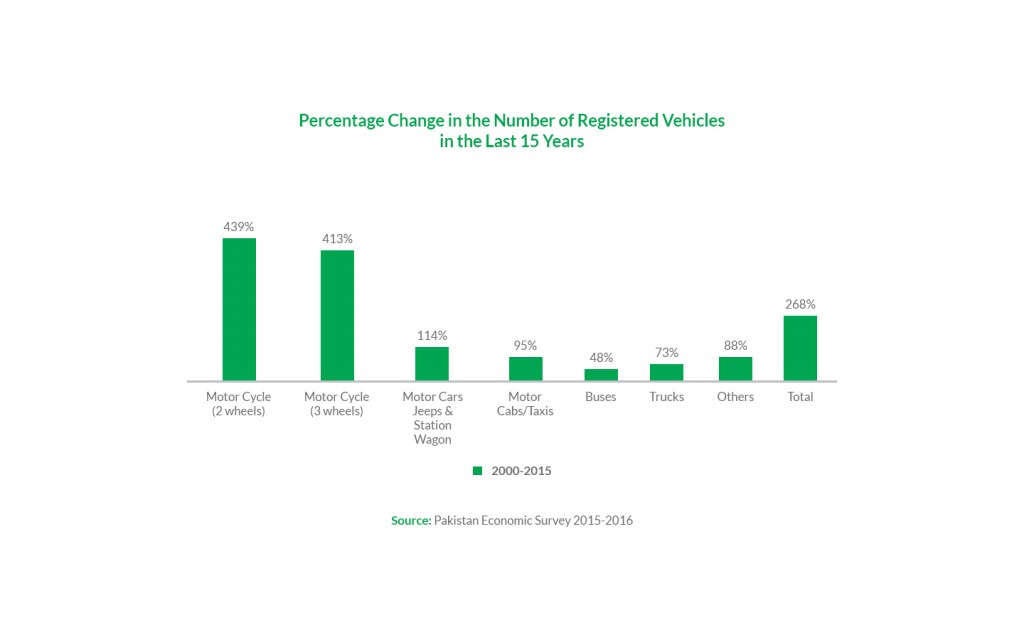Pakistan has seen a dramatic growth in number of vehicles over the last two decades. According to Punjab Development Statistics, as of 2017, almost 17 million vehicles have been registered in Punjab alone of which only 0.7 million are public transport vehicles which include rikshaws, cabs/taxis and buses. Over 13 million are two-wheeler motorcycles. Motor cars, jeeps and station wagons number 1.95 million, taxis 0.07 million, buses 0.17 million, and trucks 0.08 million.
A 2016 study by Gallup Pakistan reveals that the number of registered motor vehicles in Pakistan increased by 268% in the years between 2000 to 2015. Over the same period, the number of private vehicles increased by 327%, whereas number of public transport vehicles increased by only 167%. Two-wheeler motorcycles alone, increased by dramatic 439%. On contrary, registered buses increased by only 48%.

It can be seen in the figure that private transport vehicles contributed disproportionately to the growth in vehicles, motorcycles being the biggest contributor. This has resulted in a significant increase in congestion on roads.
Both demand and supply side factors explain the dramatic growth in number of vehicles. On the demand side, the two important drivers are population growth and increase in average household income.
The population of Pakistan increased from 132.352 million in 1998 to 207.774 million in 2017. According to UNDP, Pakistan is the sixth most populous country in the world, and has the highest population growth rate in South Asia at 2.40 percent. With rising population, the increase in people’s travel demand is inevitable. The travel demands of this large population, unmet by inadequate and inefficient supply of public transport gives rise to increased use of privately owned vehicles, resulting in road congestion.
The metropolitan cities in Punjab such as Lahore and Rawalpindi have populations of more than ten and two million repectively . Urbanization and migration from rural areas to these cities has made congestion in these cities a grave concern. Interestingly, the number of registered vehicles in these cities are also the highest in the region. Lahore division alone, had 5.4 million registered vehicles while Rawalpindi division had 1.5 million registered vehicles.
Since, private modes of transport are costly as compared to public transport, their increased use, especially that of motor cycles suggests that affordability of people has increased over years. This is partly evident from the increase in income per capita, especially among the low-income groups.
The data from Household Economic Integrated Survey (HIES) 2015-16 show a significant increase in average monthly income of households. The average monthly household income of Pakistan increased from PKR 30,999 in the year 2013-14 to 35,663 in the year 2015-16, according to. The percentage increase in income is slightly higher in urban areas as compared to rural areas. Similarly, the percentage increase in income is slightly higher (around 0.13%) among lower income quintile groups. If we consider the trend of increase in income for a larger period, these figures are even higher. In 2005, the average household income was Rs. 9685. This means from 2005 to 2016, average household income increased by 368%.
On the supply side, manufacturing of motorcycles has increased significantly over years. Since their prices have not gone up substantially despite the soaring inflation, motorcycles are available at highly affordable prices. Moreover, credit access such as car and motor cycle loan financing facilities -offering products with attractive installment plans such as Honda motor cycle loans with maturity of as long as three years- significantly enhanced vehicle affordability of households.
Thus, there is a persisting trend of vehicle growth, especially that of motorcycles in Pakistan. With growing population and improved affordability, this trend can only be expected to continue in the future. Hence, an efficient traffic management system, especially one with a special focus on motor cycles management is necessary. Influencing the choice of transport mode by providing cost-efficient and time saving alternatives would be desirable. Stringent licensing requirements, providing public transport or ride sharing services, banning the use of motor cycles on congested roads such as Firozpur road in Lahore, and designating separate lanes for motor cycles could be some of the appropriate solutions. More on that in Part-II.



